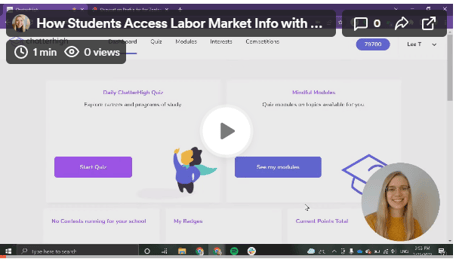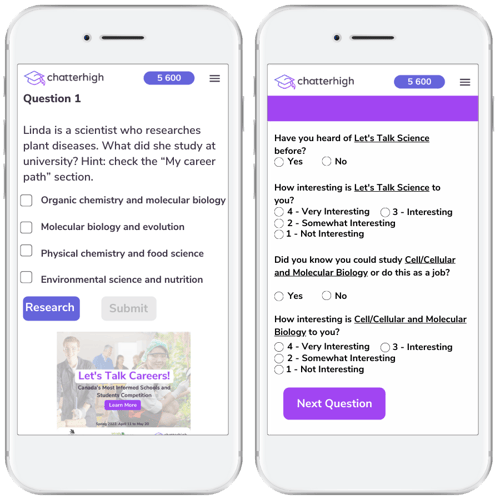How ChatterHigh Connects Students to Labour Market Information
by Julia McDonald on 31 Mar, 2022
Career exploration needs to do more than introduce students to exciting jobs. It needs to equip students to make informed decisions by connecting them to labour market information. Thankfully, career exploration on ChatterHigh does exactly that.
TL;DR Summary
In a rush? Here’s the scoop on how ChatterHigh connects students to relevant labour market resources.
- ChatterHigh Daily Quiz questions are coded using national classifications for occupations (NOC and SOC) and post-secondary programs (CIP)
- Students can use these codes to dive deeper and discover more program and career options
- Using career resources that are linked in their ChatterHigh Interests Profile, students can find relevant labour market information on the jobs that interest them
Take a minute to learn more by watching the video

When it comes to career exploration, we want to do more than introduce students to a list of potential jobs. At ChatterHigh, our vision is to see a world full of hopeful, adaptable, and empowered young adults. That’s why we’re determined to help students:
- Explore the vast diversity of careers in the job market, not just a job or two
- Discover careers that capture their interests
- Use real-world resources to make informed decisions as they plan their post-secondary pathways
In fact, our career exploration activity, the Daily Quiz, is designed to accomplish all three of these goals. First, the Daily Quiz exposes students to all general areas of study within the first 100 questions! Second, after a student has answered 100 questions, the Daily Quiz begins to personalize the activity to the student. In other words, after answering 100 questions, students begin to receive questions about jobs and programs they’ve expressed interest in.
>>To learn more about how ChatterHigh offers personalized career exploration, click here.<<
-1.png?width=600&name=blog%20images%20wide_EN%20(3)-1.png)
Now let’s talk about that third goal, helping students use real-world resources to make informed decisions as they plan their post-secondary pathways. This goal is all about making career exploration concrete. We love it when students are excited to explore and discover career options. But we love it even more when students are equipped to take the practical steps to turn their career aspirations into reality. So, to help students take those steps, we do what we like to call the NOC, SOC, and Roll. Here’s a summary of how it works:
- We use Canada’s National Occupational Classification (NOC) and the United States’ Standard Occupational Classification (SOC) to classify the jobs students discover through our quiz.
- To help students “roll” along their post-secondary pathway, we use the Classification of Instructional Programs (CIP) to classify the college and university programs that students discover.
- Then, if a student is interested in a job or program, the platform records the codes in a student’s profile so that they can dig deeper into them later using these real-world resources.
What exactly are these classifications? In short, they are hierarchical structures used to classify jobs, in the case of the NOC and SOC, and instructional programs, in the case of the CIP. For more detailed information, see the descriptions below.
NOC, SOC, and CIP Explained
The National Occupational Classification (NOC) is a “four-tiered hierarchical structure.” It starts with 10 broad categories, which are broken down further into 40 major groups, 140 minor groups, and 500 unit groups.
The Standard Occupational Classification (SOC) “is a federal statistical standard used by federal agencies to classify workers into occupational categories.” It is organized into a four-tiered hierarchical structure with 23 major groups, 98 minor groups, 459 broad occupations, and 867 detailed occupations.
The Classification of Instructional Programs (CIP) is a hierarchical classification “used for classifying instructional programs according to field of study” that was first created by the National Center for Education Statistics (NCES) in the United States. Each program in this classification has a detailed description and several examples of programs that belong to its class.
Why Use Occupational and Instructional Classifications
Now let’s see how all this helps students engage in meaningful and practical career exploration. At ChatterHigh, we use these classifications to “code” our questions, such as the one you see below.

Thanks to the Interest and Awareness Survey that follows job- and program-oriented Daily Quiz questions, any post-secondary pathway that interests a student can be easily saved so that they can dig deeper into it later. All they have to do is indicate interest in the job/program by selecting “Very Interesting” or “Interesting” in the final survey question.
Now here’s the main point: When the NOC, SOC, and CIP work together with the Interest and Awareness Survey, students not only have a hassle-free way of recording every post-secondary pathway that piques their interest but they are also given the tools to learn about market information relevant to their interests. That’s because when students go to their Interests Profile on ChatterHigh, they will see all the CIP codes associated with the majors and programs they found interesting, as well as the NOC or SOC codes for all the jobs that intrigued them, depending on where they are in North America. More than that, at the bottom of the Job & Career page of their Interests Profile, they’ll find a link to either the NOC or SOC online resource along with instructions on how to use the codes to continue their career exploration. Thanks to this information and these tools, students can do two things:
1. They can access labour market information for the jobs that interest them.
By going to the "Job & Career" tab of their Interests Profile, students can access all the occupational classification codes of jobs that interested them. To access labour market information about these jobs, all they need to do is click the Career resource button at the bottom of their screen. This will take them to a national or regional labour market resource where they can search for the occupations that interest them to learn relevant information such as required education, salary, and job outlook.
2. They can explore jobs and programs similar to those that have already piqued their interest by using the NOC, SOC, and CIP hierarchical classifications.
The organized structure of these classifications allows students to easily find other opportunities like ones they’ve already shown interest in. For example, if a student received the question we saw earlier and ranked Cell/Cellular and Molecular Biology as Very Interesting or Interesting, they could simply click on the "Major & Program" tab of their Interests Profile and find the CIP code for Cell/Cellular and Molecular Biology.
-1.png?width=524&height=349&name=blog%20images%20wide_EN%20(4)-1.png)
Then, they could use the CIP hierarchy to find other programs that fall into the same subcategory as Cell/Cellular and Molecular Biology.
-1.png?width=531&height=354&name=blog%20images%20wide_EN%20(5)-1.png)
Conclusion
Career exploration is vital to helping students make informed decisions. But how informed they are depends on how deep they dig during their exploration. At ChatterHigh, we want to help students take advantage of the variety of resources out there, including the resources that maybe weren’t designed with them in mind. The good news: those resources don’t have to be student-centric because our platform is. So what are you waiting for? Let’s help students knock their career exploration out of the park with the NOC, SOC, and Roll approach.
Create an account on ChatterHigh now.
